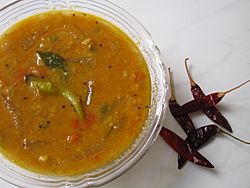Sambar (dish) facts for kids
 |
|
| Type | Spiced curry stew |
|---|---|
| Place of origin | India |
| Region or state | Maharashtra, South India, Sri Lanka, Myanmar (Burma) |
| Serving temperature | Hot |
| Main ingredients | Tamarind broth, lentils, vegetables |
| 139 kcal (582 kJ) | |
Sambar is a yummy and healthy stew from South India and Sri Lanka. It's made mostly with lentils and lots of vegetables, all cooked in a tangy tamarind sauce. People often eat it hot with rice, idli, or dosa. It's also popular in Myanmar (Burma) where it's served with their curries.
The Story of Sambar
Have you ever wondered where Sambar came from? Food experts say that people first wrote about Sambar around the 1600s. This was in a place called Tamilakam, which is now part of South India.
The word sambar comes from an old Tamil word, champāram. This word meant a dish of rice served with other spiced dishes. It also referred to ingredients used to cook vegetable rice.
Around the year 1530, an old writing in Tamil mentioned champāram. It talked about "cooked rice offerings, including curry rice, many types of spiced rice, and ghee rice." This shows that champāram was an important part of meals a long time ago!
Sambar Around the World
Sambar is loved in many places, and each place has its own special way of making it!
In Myanmar, people call Sambar by different names. These include thizone chinyay hin (which means "assorted vegetables sour soup") or thizone pe kala hin ("assorted vegetables chickpea soup").
The Burmese version of Sambar often includes dried salted fish. It also has a mix of vegetables like eggplants, okra, moringa, gourds, green beans, and potatoes. The soup base is made from mashed chickpeas. It gets its flavor from ripe tamarind, curry leaves, and other spices like cumin, chilies, onions, and garlic.
See also
 In Spanish: Sambhar para niños
In Spanish: Sambhar para niños

